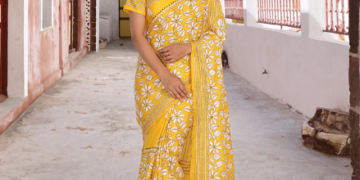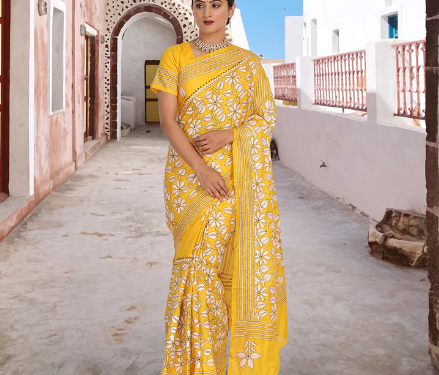Unveiling the Timeless Elegance of the Indian Sari Dress
Introduction
The allure of the Indian Sari Dress transcends time and borders. This traditional attire embodies elegance, grace, and a rich cultural heritage that has been cherished for centuries. In this detailed exploration, we will delve into the enchanting world of the Indian Sari Dress, from its origins to its contemporary relevance. Join us on this journey as we unravel the timeless elegance of this iconic garment.
The History of the Sari
The history of the Indian sari dress is a tapestry of tradition and innovation. From its inception in ancient India to its evolution into various regional styles, the sari has a captivating story to tell.
Ancient Origins
The origins of the sari can be traced back to as early as 2800-1800 BC. It was initially referred to as ‘sati,’ a Sanskrit word meaning ‘strip of cloth.’ These ancient saris were a symbol of simplicity and modesty, consisting of unstitched lengths of fabric draped gracefully.
Regional Variations
India’s diverse culture gave rise to a multitude of regional sari styles. From the vibrant Bandhani of Gujarat to the intricate Kanjivarams of Tamil Nadu, each state boasts its own unique sari tradition. These variations reflect the diverse aesthetics and craftsmanship of India.
Draping Styles
The art of draping a sari is an integral part of its elegance. Different regions have distinct draping styles, each with its own charm.
Nivi Style
The Nivi style, hailing from Andhra Pradesh, is one of the most popular and versatile draping methods. It involves neatly pleating the sari and allowing it to flow gracefully over the shoulder, creating an aura of sophistication.
Bengali Drapes
Bengal’s sari draping styles are characterized by the use of bold, striking pleats. The sari is often paired with ornate jewellery, making it a symbol of cultural opulence.
Maharashtrian Drape
In Maharashtra, the sari is draped in a unique manner, with the pallu (the loose end) tucked neatly at the back. This style allows for ease of movement and is preferred by many working women.
The Influence of Bollywood
Bollywood, India’s thriving film industry, has played a significant role in popularizing the sari worldwide. Iconic actresses like Rekha and Sridevi have adorned exquisite saris in their films, inspiring fashion trends that endure to this day.
Modern Adaptations
The Indian Sari Dress has not remained stagnant; it has evolved to meet contemporary fashion sensibilities. Designers have incorporated modern elements while preserving the sari’s timeless charm.
Fusion Styles
Sari gowns, pre-draped saris, and sari lehengas are some of the innovative fusion styles that blend traditional aesthetics with modern convenience.
Sustainable Fashion
In recent years, there has been a resurgence of interest in sustainable fashion. Handwoven saris using eco-friendly materials have gained popularity, aligning with the global trend toward conscious consumption.
Cultural Significance
The sari holds immense cultural significance in India. It is worn on various occasions and reflects the wearer’s social, marital, and regional identity.
Bridal Attire
In many Indian cultures, the bride adorns a special bridal sari on her wedding day. These saris are often red or adorned with intricate embroidery, symbolizing love and auspiciousness.
Festival Wear
During festivals like Diwali and Durga Puja, women don their finest saris to celebrate the occasion. The sari’s vivid colours and intricate designs add to the festive atmosphere.
FAQs
Q: How long does it take to drape a sari perfectly?
A: Draping a sari perfectly can take some practice. With experience, it can be done in 10-15 minutes.
Q: Can men wear saris?
A: While the sari is traditionally worn by women, there is a growing trend of gender-neutral fashion, allowing anyone to explore this beautiful attire.
Q: What is the significance of the sari’s pallu?
A: The pallu of a sari is often used to cover the head as a sign of respect or modesty in traditional Indian culture.
Q: Are there specific colours for mourning in saris?
A: Yes, in some Indian cultures, white is considered a colour of mourning and is avoided on festive occasions.
Q: Can I wear a sari for a casual outing?
A: Absolutely! Saris come in a variety of fabrics and styles, making them suitable for both formal events and casual outings.
Q: How do I maintain and clean my sari?
A: Saris require delicate care. Dry cleaning is often recommended to preserve their beauty. However, some saris can be hand-washed with care.
Conclusion
The Indian Sari Dress stands as a testament to the enduring elegance of traditional attire. From its humble beginnings to its global appeal, the sari continues to be a symbol of grace and cultural richness. Whether worn on special occasions or integrated into modern fashion, the sari’s timeless charm remains unaltered. Unveiling the Timeless Elegance of the Indian Sari Dress is not just an exploration of clothing but a journey through the heart of Indian culture.
























































